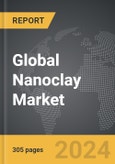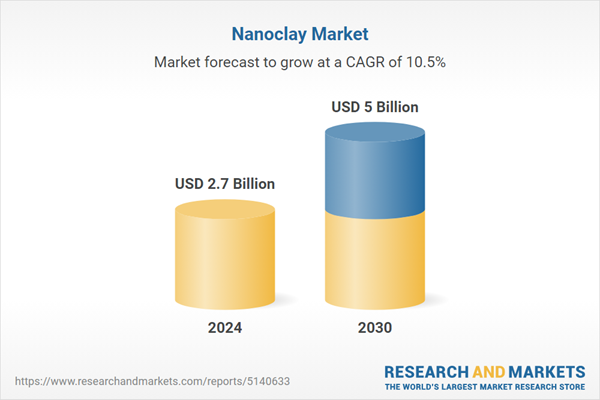The global market for Nanoclay was valued at US$2.7 Billion in 2024 and is projected to reach US$5.0 Billion by 2030, growing at a CAGR of 10.5% from 2024 to 2030. This comprehensive report provides an in-depth analysis of market trends, drivers, and forecasts, helping you make informed business decisions. The report includes the most recent global tariff developments and how they impact the Nanoclay market.
The production of nanoclay involves sophisticated techniques such as sol-gel processing, in-situ polymerization, and melt-intercalation. Each of these methods is tailored to achieve specific properties and ensure compatibility with different polymers. Sol-gel processing, for example, is used to produce highly pure nanoclay with controlled porosity, whereas in-situ polymerization helps in the direct formation of nanocomposites within a polymer matrix. Melt intercalation, on the other hand, involves the dispersion of nanoclay into a molten polymer, resulting in uniform and stable nanocomposites. These unique production techniques leverage the high aspect ratio and large surface area of nanoclay, which contribute to its superior mechanical reinforcement capabilities. In the packaging industry, nanoclay composites significantly enhance barrier properties against gases and moisture, thereby extending the shelf life of perishable goods. In the automotive industry, the integration of nanoclay into polymer matrices results in lighter and stronger components, which contribute to fuel efficiency and reduced emissions. Additionally, the construction sector benefits from nanoclay’s ability to improve the durability and fire resistance of building materials. The versatile nature of nanoclay continues to drive innovation across these fields, reflecting its substantial impact on modern material science.
The growth in the nanoclay market is driven by several factors, including technological advancements, increasing demand for high-performance materials, and the push for sustainability. Technological advancements have enabled the production of nanoclay with more consistent and desirable properties, making them suitable for high-value applications. The automotive and aerospace industries, in particular, have seen a surge in demand for components that offer superior strength-to-weight ratios and enhanced durability, driven by the necessity for improved fuel efficiency and performance. Consumer behavior is also shifting towards products that offer both better performance and environmental benefits, propelling the market for nanoclay-based composites. In the construction industry, there is a growing need for materials that can enhance building longevity and safety, especially regarding fire resistance. Regulatory frameworks aimed at reducing carbon footprints and encouraging the use of sustainable materials further support the widespread adoption of nanoclay. Additionally, the packaging industry's demand for materials that can provide enhanced barrier properties and extend product shelf life aligns with the capabilities of nanoclay composites. The convergence of these factors underscores the robust expansion of the nanoclay market, highlighting its crucial role in advancing material technology and addressing contemporary industrial challenges.
Segments: Product Type (Smectite, Kaolinite, Other Product Types); End-Use (Packaging, Automotive, Paints & Coatings, Flame Retardants, Other End-Uses).
Geographic Regions/Countries: World; USA; Canada; Japan; China; Europe; France; Germany; Italy; UK; Rest of Europe; Asia-Pacific; Rest of World.
The analysts continuously track trade developments worldwide, drawing insights from leading global economists and over 200 industry and policy institutions, including think tanks, trade organizations, and national economic advisory bodies. This intelligence is integrated into forecasting models to provide timely, data-driven analysis of emerging risks and opportunities.
Global Nanoclay Market - Key Trends & Drivers Summarized
Nanoclay, a subclass of nanoparticles, is composed of layered mineral silicates with a thickness of approximately 1 nanometer and surface dimensions that typically range from 70 to 150 nanometers. These materials are primarily derived from natural clay sources such as montmorillonite, bentonite, and kaolinite. Nanoclays possess unique properties that set them apart from traditional bulk clays, primarily due to their high aspect ratio and the potential to form intercalated or exfoliated nanocomposites when combined with polymers. These nanocomposites exhibit significantly enhanced mechanical, thermal, and barrier properties compared to their base materials. As a result, nanoclay has become a critical component in a wide array of applications including packaging, automotive parts, construction materials, and flame retardants. The increasing focus on sustainability and eco-friendly materials has further fueled research and development in nanoclay technologies, aiming to optimize their performance and expand their range of applications.The production of nanoclay involves sophisticated techniques such as sol-gel processing, in-situ polymerization, and melt-intercalation. Each of these methods is tailored to achieve specific properties and ensure compatibility with different polymers. Sol-gel processing, for example, is used to produce highly pure nanoclay with controlled porosity, whereas in-situ polymerization helps in the direct formation of nanocomposites within a polymer matrix. Melt intercalation, on the other hand, involves the dispersion of nanoclay into a molten polymer, resulting in uniform and stable nanocomposites. These unique production techniques leverage the high aspect ratio and large surface area of nanoclay, which contribute to its superior mechanical reinforcement capabilities. In the packaging industry, nanoclay composites significantly enhance barrier properties against gases and moisture, thereby extending the shelf life of perishable goods. In the automotive industry, the integration of nanoclay into polymer matrices results in lighter and stronger components, which contribute to fuel efficiency and reduced emissions. Additionally, the construction sector benefits from nanoclay’s ability to improve the durability and fire resistance of building materials. The versatile nature of nanoclay continues to drive innovation across these fields, reflecting its substantial impact on modern material science.
The growth in the nanoclay market is driven by several factors, including technological advancements, increasing demand for high-performance materials, and the push for sustainability. Technological advancements have enabled the production of nanoclay with more consistent and desirable properties, making them suitable for high-value applications. The automotive and aerospace industries, in particular, have seen a surge in demand for components that offer superior strength-to-weight ratios and enhanced durability, driven by the necessity for improved fuel efficiency and performance. Consumer behavior is also shifting towards products that offer both better performance and environmental benefits, propelling the market for nanoclay-based composites. In the construction industry, there is a growing need for materials that can enhance building longevity and safety, especially regarding fire resistance. Regulatory frameworks aimed at reducing carbon footprints and encouraging the use of sustainable materials further support the widespread adoption of nanoclay. Additionally, the packaging industry's demand for materials that can provide enhanced barrier properties and extend product shelf life aligns with the capabilities of nanoclay composites. The convergence of these factors underscores the robust expansion of the nanoclay market, highlighting its crucial role in advancing material technology and addressing contemporary industrial challenges.
Report Scope
The report analyzes the Nanoclay market, presented in terms of units. The analysis covers the key segments and geographic regions outlined below.Segments: Product Type (Smectite, Kaolinite, Other Product Types); End-Use (Packaging, Automotive, Paints & Coatings, Flame Retardants, Other End-Uses).
Geographic Regions/Countries: World; USA; Canada; Japan; China; Europe; France; Germany; Italy; UK; Rest of Europe; Asia-Pacific; Rest of World.
Key Insights:
- Market Growth: Understand the significant growth trajectory of the Smectite segment, which is expected to reach US$3.0 Billion by 2030 with a CAGR of a 11.6%. The Kaolinite segment is also set to grow at 9.4% CAGR over the analysis period.
- Regional Analysis: Gain insights into the U.S. market, valued at $746.7 Million in 2024, and China, forecasted to grow at an impressive 13.0% CAGR to reach $466.8 Million by 2030. Discover growth trends in other key regions, including Japan, Canada, Germany, and the Asia-Pacific.
Why You Should Buy This Report:
- Detailed Market Analysis: Access a thorough analysis of the Global Nanoclay Market, covering all major geographic regions and market segments.
- Competitive Insights: Get an overview of the competitive landscape, including the market presence of major players across different geographies.
- Future Trends and Drivers: Understand the key trends and drivers shaping the future of the Global Nanoclay Market.
- Actionable Insights: Benefit from actionable insights that can help you identify new revenue opportunities and make strategic business decisions.
Key Questions Answered:
- How is the Global Nanoclay Market expected to evolve by 2030?
- What are the main drivers and restraints affecting the market?
- Which market segments will grow the most over the forecast period?
- How will market shares for different regions and segments change by 2030?
- Who are the leading players in the market, and what are their prospects?
Report Features:
- Comprehensive Market Data: Independent analysis of annual sales and market forecasts in US$ Million from 2024 to 2030.
- In-Depth Regional Analysis: Detailed insights into key markets, including the U.S., China, Japan, Canada, Europe, Asia-Pacific, Latin America, Middle East, and Africa.
- Company Profiles: Coverage of players such as Active Minerals International LLC, Britex Enterprises, GX International, Inc., Kunimine Industries Co. Ltd, Renovos and more.
- Complimentary Updates: Receive free report updates for one year to keep you informed of the latest market developments.
Some of the 83 companies featured in this Nanoclay market report include:
- Active Minerals International LLC
- Britex Enterprises
- GX International, Inc.
- Kunimine Industries Co. Ltd
- Renovos
- RTP Company
- Techmer PM
Tariff Impact Analysis: Key Insights for 2025
Global tariff negotiations across 180+ countries are reshaping supply chains, costs, and competitiveness. This report reflects the latest developments as of April 2025 and incorporates forward-looking insights into the market outlook.The analysts continuously track trade developments worldwide, drawing insights from leading global economists and over 200 industry and policy institutions, including think tanks, trade organizations, and national economic advisory bodies. This intelligence is integrated into forecasting models to provide timely, data-driven analysis of emerging risks and opportunities.
What’s Included in This Edition:
- Tariff-adjusted market forecasts by region and segment
- Analysis of cost and supply chain implications by sourcing and trade exposure
- Strategic insights into geographic shifts
Buyers receive a free July 2025 update with:
- Finalized tariff impacts and new trade agreement effects
- Updated projections reflecting global sourcing and cost shifts
- Expanded country-specific coverage across the industry
Table of Contents
I. METHODOLOGYII. EXECUTIVE SUMMARY2. FOCUS ON SELECT PLAYERSIII. MARKET ANALYSISIV. COMPETITION
1. MARKET OVERVIEW
3. MARKET TRENDS & DRIVERS
4. GLOBAL MARKET PERSPECTIVE
UNITED STATES
CANADA
JAPAN
CHINA
EUROPE
FRANCE
GERMANY
ITALY
UNITED KINGDOM
REST OF EUROPE
ASIA-PACIFIC
REST OF WORLD
Companies Mentioned (Partial List)
A selection of companies mentioned in this report includes, but is not limited to:
- Active Minerals International LLC
- Britex Enterprises
- GX International, Inc.
- Kunimine Industries Co. Ltd
- Renovos
- RTP Company
- Techmer PM
Table Information
| Report Attribute | Details |
|---|---|
| No. of Pages | 305 |
| Published | April 2025 |
| Forecast Period | 2024 - 2030 |
| Estimated Market Value ( USD | $ 2.7 Billion |
| Forecasted Market Value ( USD | $ 5 Billion |
| Compound Annual Growth Rate | 10.5% |
| Regions Covered | Global |









